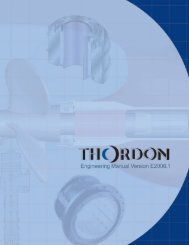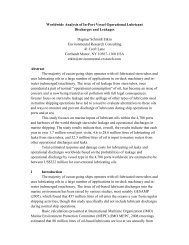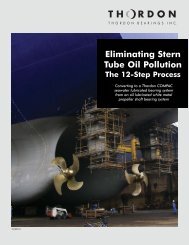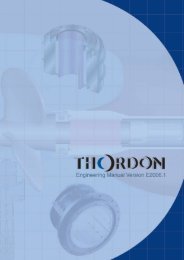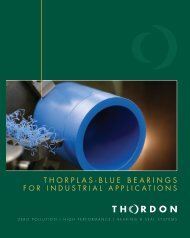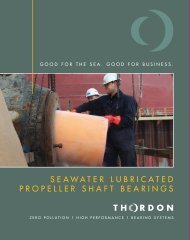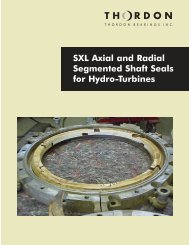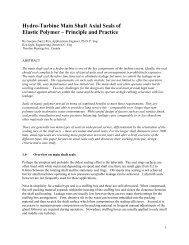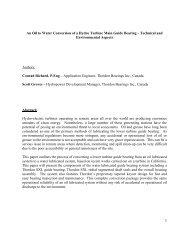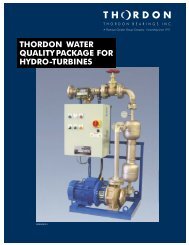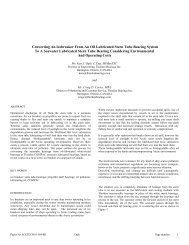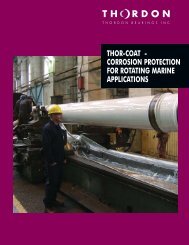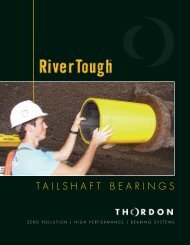ThorPlas Engineering Manual - Thordon Bearings
ThorPlas Engineering Manual - Thordon Bearings
ThorPlas Engineering Manual - Thordon Bearings
You also want an ePaper? Increase the reach of your titles
YUMPU automatically turns print PDFs into web optimized ePapers that Google loves.
DESIGN GUIDE<br />
g) Mating Surface<br />
Most common metallic mating surfaces will perform<br />
well when used in conjunction with <strong>ThorPlas</strong> bearings.<br />
If corrosion is a concern, a corrosion resistant mating<br />
surface should be used. Stainless steel is frequently used<br />
for corrosion resistance. Bronze shafts or liners can also<br />
be used. Do not run <strong>ThorPlas</strong> on corroded surfaces as this<br />
will result in accelerated bearing wear. Common bronzes<br />
that work well include Gunmetal (88% Cu, 10% Sn and<br />
2% Zn) or 70-30 Copper Nickel. Optimum shaft hardness<br />
is 40 Rockwell C; satisfactory performance is achieved<br />
with hardness above 20 Rockwell C.<br />
<strong>ThorPlas</strong> should not be used with a non-metallic<br />
mating surface.<br />
The surface finish of the mating shaft should be as<br />
smooth as practical to limit the initial bedding-in wear.<br />
<strong>Thordon</strong> testing has shown that less frictional heat<br />
is generated with a smoother shaft. For optimum<br />
performance, a final machined surface finish of 0.8 micrometres<br />
(32 micro-inches) is recommended. Mating surface<br />
finishes up to 1.6 micro-metres (63 micro-inches) will<br />
perform satisfactorily. Where the application involves<br />
axial movement, the shaft finish should not exceed<br />
0.8 micro-metres (32 micro-inches).<br />
h) Fitting<br />
<strong>ThorPlas</strong> bearings are usually fitted with an interference<br />
fit. Freeze fitting is recommended but press fitting can<br />
be used as long as care is taken to avoid direct impact<br />
on the material. A combination of freeze fitting and<br />
press fitting is recommended for bearings with high<br />
interference. See Section 6 - Installation Guidelines for<br />
detailed freeze and press fitting instructions.<br />
Bonding of <strong>ThorPlas</strong> bearings is not recommended.<br />
If <strong>ThorPlas</strong> bearings are exposed to temperatures above<br />
70°C (158°F) mechanical retention – retaining rings or<br />
pins – should be used.<br />
Both the O.D. and I.D. of a <strong>ThorPlas</strong> bearing should be<br />
machined prior to installation. Machining of the bearing<br />
I.D. after fitting should be avoided because of the<br />
negative impact the removal of the material will have<br />
on the interference interface pressure whose stress is<br />
concentrated on the I.D. of the bearing.<br />
i) L/D Ratio<br />
To facilitate installation and to provide reasonable bearing<br />
operation, the recommended Length to Diameter ratios<br />
(L/D) for <strong>ThorPlas</strong> are:<br />
Maximum L/D ratio: 2:1<br />
Minimum L/D ratio: 1:1<br />
For larger or smaller L/D ratios, please consult with<br />
<strong>Thordon</strong> <strong>Bearings</strong> Inc.<br />
10<br />
j) Abrasive Environment<br />
Although <strong>ThorPlas</strong> is more abrasive resistant than the<br />
majority of metallic and non-metallic bearing materials,<br />
it will perform better if it has less contact with abrasives.<br />
For high pressure bearings which may be exposed to water,<br />
especially those with oscillating motion and no flow of<br />
water, <strong>Thordon</strong> recommends the use of Thorseals® in<br />
recessed grooves near the ends of the bearing to prevent<br />
abrasive ingress. In other cases, a clean water flush may<br />
offer a practical alternative.<br />
<strong>ThorPlas</strong> wicket gate bearing with Thorseal<br />
k) Impact and Shock Loads<br />
<strong>ThorPlas</strong> can withstand impact and shock loading,<br />
however, the bearing must be fully supported in this<br />
type of application. For applications with significant<br />
shock/impact, <strong>Thordon</strong> elastomer bearing grades should<br />
be evaluated.<br />
This example indicates that the <strong>ThorPlas</strong> bearing chamfers<br />
were too long and as the bearing was loaded in this area,<br />
not enough support was available for the material to take<br />
the load. Although the bearing cracked, it did not shatter<br />
and remained in one piece.



